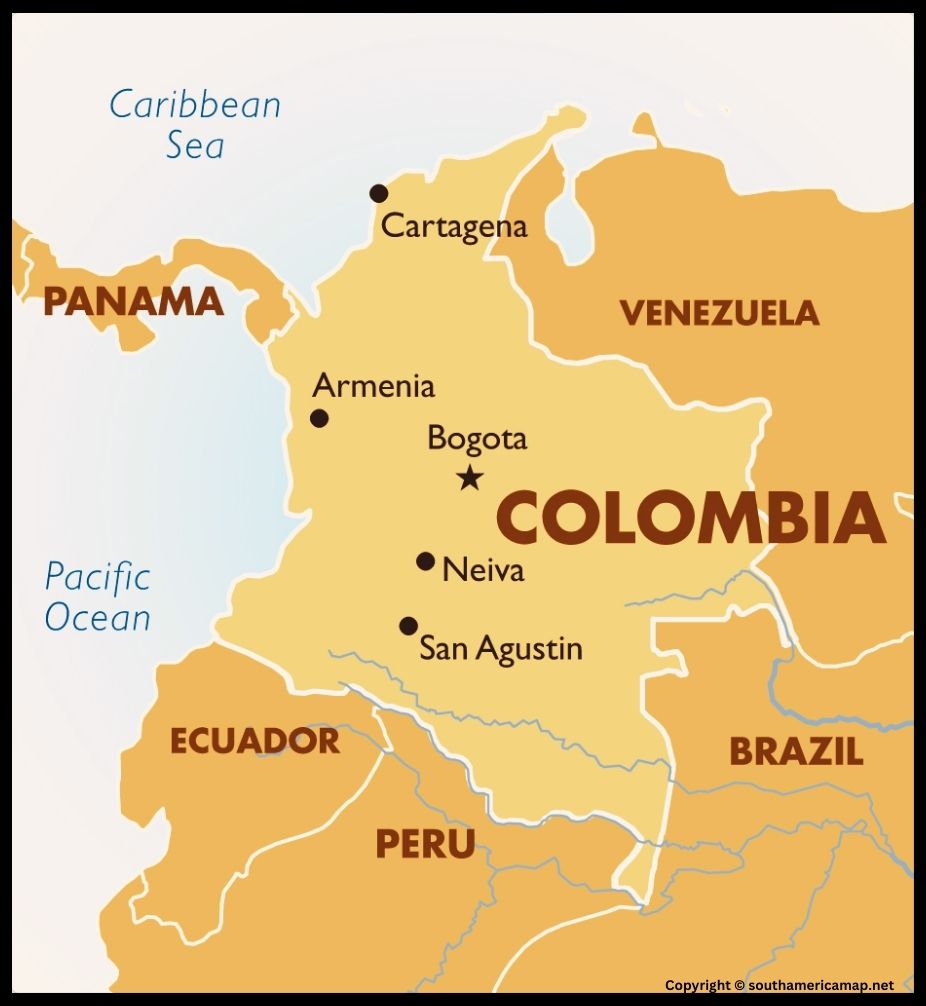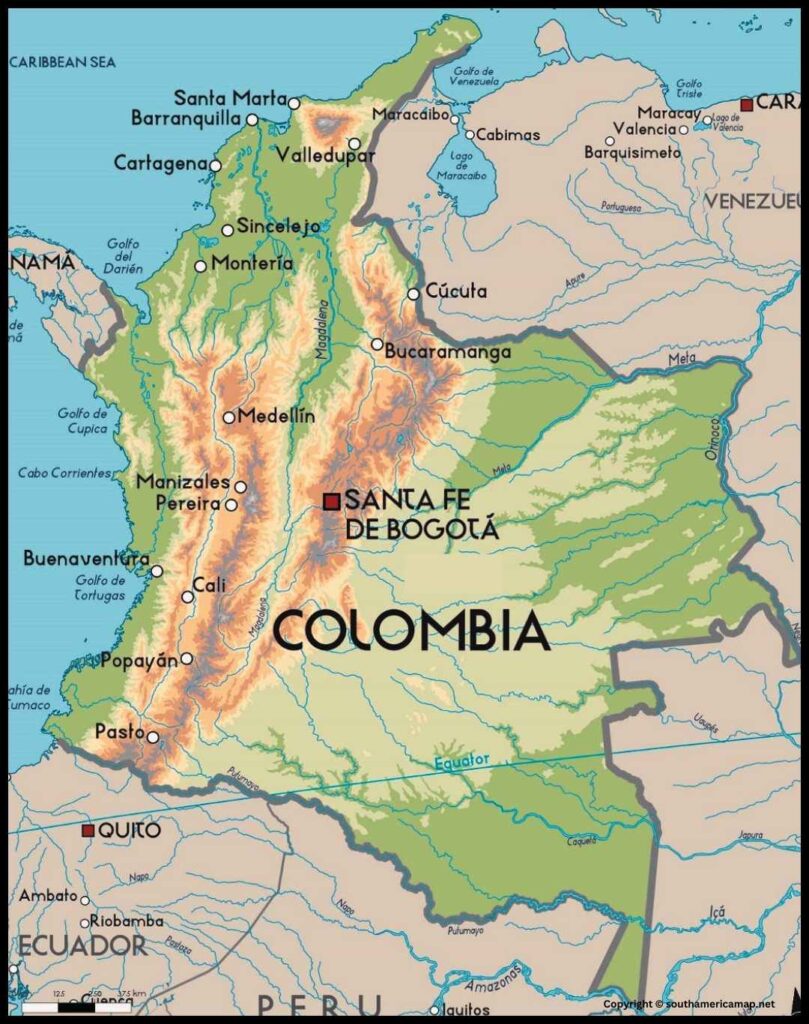Map of Colombia South America – North -West South America is a nation to force geographical diversity and historical significance in South America. It is surrounded using Venezuela in the east, Brazil in the south, Peru, Ecuador and Panama in the south and the Caribbean Sea in the north. Columbia is strategic and fully located on the continent.
The topography of the USA is characterized by the path of the extension ends mountain variety, which cuts its western spine, sculpted the landscape, and provides beautiful landscape. With the chanting aspect, the important Amazon Rainews provides the rich biodiversity of Colombia. The northern coast is washed through a good and comfortable water of the Caribbean Sea, when the West Coast opens into the Pacific Ocean.
Equatorials in the US ensure the presence of tropical weather with moist and dry seasons, sell rich ecosystems and allow the United States to maintain their agricultural production. In addition to the natural points of its interest, Colombia’s geography has predicted prominently in its cultural and monetary relations and turned it into a colorful intersection in South America.
Related Post –
Map of Colombia South America [Columbia South America Map]
A map of Colombia in South America is an invaluable asset to anyone interested in experiencing, learning about, and enjoying the diverse and vibrant nation of Colombia. It has numerous advantages, such as:
1. Education:
- Visualizing Colombia’s geography: A labeled map gives a clear and concise overview of Colombia’s position in South America, its borders, major cities, physical features (Andes Mountains, Amazon rainforest, Caribbean coast, etc.), and bodies of water (Magdalena River, Pacific Ocean, etc.). The visual representation facilitates learning about Colombia’s geography and its varied landscapes.
- Understanding the relationships between different regions: Labels on the map assist in linking cities, regions, and physical features, enabling better understanding of Colombia’s internal geography and how various parts of the country relate to each other.
- Enabling research and discovery: Map can be the point of departure for research projects on individual regions, places of interest, natural attractions of Colombia. The map can be utilized by students and researchers to find places of interest, research their culture and history, and make plans for real-life or virtual explorations.
2. Navigation:
- Planning Travel Route: Whether Sierra Nevada de Santa is required to travel in Santa Marta, a cultural tour of Cartzena, or Amazon Rainforest Yatra, a good map of Colombia is necessary to chart the routes, identify sites and find your way through an unknown area.
- Knowing the distance and transport networks: distance between cities and cities, and major roads, are marked on railway and waterways maps. It enables plans an effective journey program and knows how to go around the nation.
- Locating special places: Since labels mark cities, towns, national parks and natural miracles, a map enables passengers to easily detect special places and move around confidently.
3. Cultural appreciation:
- Learning approximately many cultures and languages: Colombia is a multicultural country that has a wealthy cultural history of indigenous agencies, Ephro-Kolambian and regional customs. A map with the label can imply regions with unique cultures and languages, which creates a higher which means of the wealthy diversity of the u . S ..
- Learning approximately political and historic backgrounds: Maps labels can mark historical sites, colonial cities and battlefields, which could talk to the improvement of Colombia’s political records and tradition.
- Enjoying natural splendor: Los Nevados National Park, espresso triangle and Tatacoa desert nominations cause the eccentric environment and biodiversity of Columbia.
4. Economic development:
- Infrastructure Tasking Planning: Planning and assignments, including maps, characters, railways, bridges and pipelines, are important in infrastructure functions, which facilitate monetary bounce and add various components of Colombia.
- Detection of sources and potential investment: A map can be used to find areas with oil, minerals and land containing land for agriculture, to trigger capacity investment and monetary development.
- Promoting Tourism: Detailed maps can be used for the layout informative vacation materials, highlighting the major tourist attractions, passenger routes and cultural activities, stimulating drawing and tourism sector for Colombia.
Map of Colombia South America Cities
Environmental protection:
- Monitoring environmental changes: Maps are used to harvesting, desert and various environmental risks, which support protection and preserve the herbal resources of Colombia.
- Project Scheme for Sustainable Reforms: MAPs help identify areas in which Akshaya power centers, environmental-environment, and sustainable farming involving permanent reform projects can be done without damaging the environment but economic reforms increase.
- Environmental Trouble recognition: Through visible presentation of environmental issues including deforestation and pollutants, maps attract attention and affect action towards keeping the environment.
In general, a map of Colombia in South America exceeds the depiction of geography; It is an important template for schooling, navigation, cultural knowledge, economic development and environmental protection. Through understanding the different uses of a map, one is capable of feeling the geography, history, sub -culture and function of Colombia in South America.
![Map of Colombia South America [Columbia South America Map]](https://southamericamap.net/wordpress/wp-content/uploads/2023/12/Map-of-Colombia-South-America-with-Cities-in-Printable-Pdf-min-933x1024.jpg)

